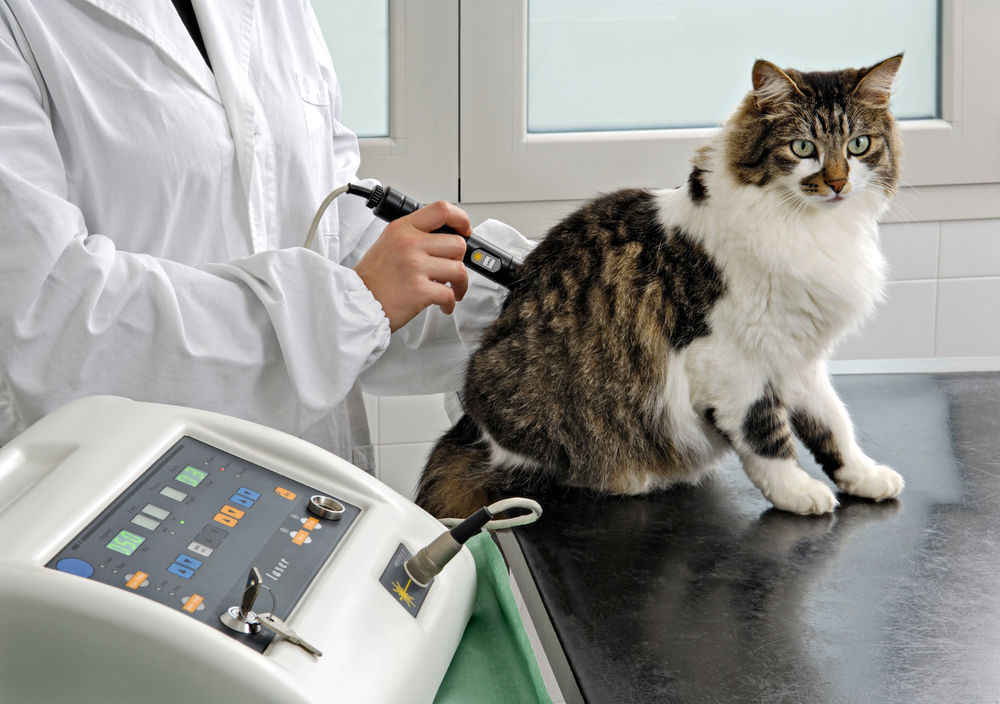Rehabilitation Services
Please contact us if you are interested in learning more about our companion laser therapy its benefits and whether this type of therapy could benefit your pet.
Please contact us if you are interested in learning more about our companion laser therapy its benefits and whether this type of therapy could benefit your pet.

Laser Therapy is a quick, non-invasive & pain-free modality that works on the principle of photo biomodulation. You may already know that laser therapy improves patient outcomes by decreasing inflammation quickly, preventing scarring and accelerating recovery time & reducing pain.
Post-surgical incision: Using therapy laser on post-surgical incision not only reduces pain but also decreases inflammation and alleviates scarring, so we offer post-surgical Spay/Neuter laser therapy.
Surgeries: Orthopedic, anal gland disease, skin growths, etc. Numerous veterinary clinical studies at the institutional level demonstrate that laser therapy can significantly reduce healing time and procedure efficiency when administered before & after surgeries. Just as an athlete would be prescribed rehab to stabilize the compromised joint, laser therapy strengthens the local biochemical environment of the tissue in a way that reduces recovery time and improves the quality of repair. Post-operative, beyond just the incision, the laser can spark the healing process & strengthen the surrounding tissue.
Chronic pain: Osteoarthritis is a quite common finding in geriatric dogs and cats which is a continuous source of moderate to severe pain in the joints. Patients having osteoarthritis reluctant to play or enjoy as the movement of joints generates pain. Delivering adequate secessions of therapy laser to these pets not only mitigates pain & inflammation but also increases the overall quality of life for these patients by increasing the range of motion in the affected joints. Chronic pain conditions are usually deep-seated & require more treatments upfront to initiate a desired response. The usual recommendations are three therapy treatments in the first week followed by a steady decrease in frequency depending upon the patient’s response. Eventually, the patient should only need a periodic maintenance treatment once every 1-2 months.
Oral treatment: Significant pain and swelling sometimes follow tooth extractions and gingivectomies. Laser therapy can reduce pain and accelerate healing of oral tissues which not only makes animals more comfortable but also decreases the required dose of potentially harmful pain medication.
Wound: wounds make up a substantial portion of our hospital caseload. Laser therapy accelerates the healing of burns, rashes, ear infections, and lick granulomas. Class IV therapy laser promotes both granulation of tissue bed and epithelization of surrounding tissue to close the wound.
Acute/sudden trauma: Sprains, strain fractures, roadside accidents, and other sudden trauma can be immediately treated with therapy laser to reduce pain and inflammation.
Platelet-rich plasma injections, or PRP injections are widely practiced in the human medicine world and now creating a new way of ground-breaking results in animals.
In PRP treatment your pet’s blood is broken down into small portions to extract healthy proteins that can be put back into your pet to help him or her regenerate healthy cells.
PRP treatment injections has been proposed to treat inflammatory conditions that affect ligaments, muscles, and tendons, Aging patients which have osteoarthritis are best benefitted from direct joint injections which not only give relief from pain but also slows down the progression of arthritis in the joints. It may also assist with bone regeneration after traumatic bone fractures. PRP has also been proposed as an aid to promote the healing of skin wounds and dental disease when it is directly injected to the site of interest.
Platelets contains alpha granules which carry substances called growth factors such as vascular endothelial growth factors (VEGF), Platelet-derived growth factor (PDGF), fibroblast growth factor-2 (FGF-2) and transforming growth factors- β (TGF-B) these growth factors are the basis of PRP therapy. Blood sample is drawn from pet’s body and through series of process with special equipment’s platelets are activated and release growth factors which are needed for beneficial effect.
Since PRP procedure uses patients own blood to harvest platelets, side effects appear to be minimal, but may include pain, irritation or bleeding at the site of injection. Patients need mild to moderate sedation for the PRP therapy procedure, so discuss risks of sedation and anesthesia with your veterinarian.